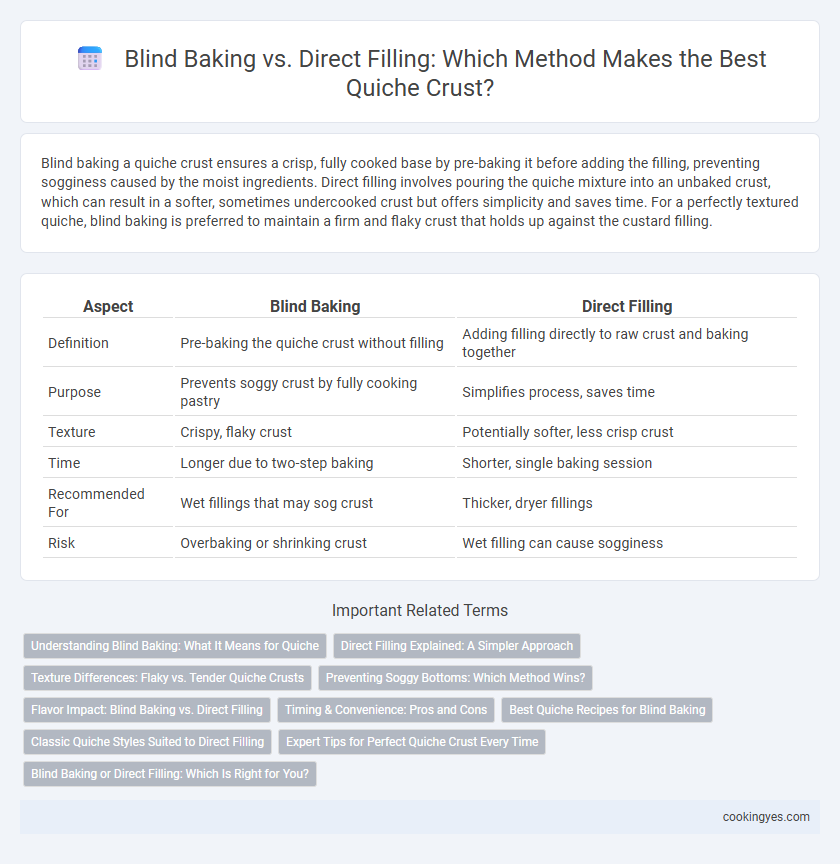Blind baking a quiche crust ensures a crisp, fully cooked base by pre-baking it before adding the filling, preventing sogginess caused by the moist ingredients. Direct filling involves pouring the quiche mixture into an unbaked crust, which can result in a softer, sometimes undercooked crust but offers simplicity and saves time. For a perfectly textured quiche, blind baking is preferred to maintain a firm and flaky crust that holds up against the custard filling.
Table of Comparison
| Aspect | Blind Baking | Direct Filling |
|---|---|---|
| Definition | Pre-baking the quiche crust without filling | Adding filling directly to raw crust and baking together |
| Purpose | Prevents soggy crust by fully cooking pastry | Simplifies process, saves time |
| Texture | Crispy, flaky crust | Potentially softer, less crisp crust |
| Time | Longer due to two-step baking | Shorter, single baking session |
| Recommended For | Wet fillings that may sog crust | Thicker, dryer fillings |
| Risk | Overbaking or shrinking crust | Wet filling can cause sogginess |
Understanding Blind Baking: What It Means for Quiche
Blind baking quiche crust involves pre-baking the pastry shell without filling to prevent sogginess and ensure a crisp texture. This method stabilizes the crust, especially important for custard-based quiches with moist fillings, by creating a barrier that stops liquid from seeping in. Direct filling, pouring custard mixture into raw dough, often results in a softer, less robust crust prone to becoming soggy under wet fillings.
Direct Filling Explained: A Simpler Approach
Direct filling for quiche crust involves pouring the custard mixture directly into an unbaked pastry shell, simplifying preparation by eliminating the blind baking step. This method relies on the moisture in the filling to bake the crust evenly, often resulting in a tender, slightly softer texture compared to traditional pre-baked crusts. Direct filling is ideal for quiches with higher moisture content fillings, as it balances crust doneness without additional handling.
Texture Differences: Flaky vs. Tender Quiche Crusts
Blind baking a quiche crust creates a flaky texture by ensuring the dough is fully cooked and crisp before adding the filling, preventing sogginess. Direct filling results in a tender crust due to the moisture from the custard mixture baking into the dough. Choosing blind baking is ideal for maintaining a distinct, crisp crust, while direct filling yields a softer, more delicate quiche base.
Preventing Soggy Bottoms: Which Method Wins?
Blind baking quiche crust involves pre-baking the pastry shell before adding the filling, effectively creating a firm, crisp barrier that prevents the custard and moisture from soaking into the dough, reducing sogginess. Direct filling skips this step, leading to a higher risk of a soggy bottom as the wet ingredients slowly seep into the unbaked crust during baking. For reliably crisp quiche crusts, blind baking is the preferred method to prevent sogginess and achieve a perfectly textured base.
Flavor Impact: Blind Baking vs. Direct Filling
Blind baking quiche crust enhances flavor by preventing sogginess and ensuring a crisp, golden texture that balances the rich filling. Direct filling often results in a softer crust due to moisture absorption, which can dilute the buttery taste and diminish overall contrast. Achieving optimal flavor and texture depends on the baking method, with blind baking providing a more pronounced, crisp crust that complements savory quiche fillings.
Timing & Convenience: Pros and Cons
Blind baking quiche crust ensures a crisp, fully cooked base and prevents sogginess by pre-baking before adding filling, which typically requires 15-20 minutes plus cooling time. Direct filling skips pre-baking, saving time and simplifying preparation but may result in a softer, less stable crust as the moisture from the filling seeps in during baking. Choosing between methods depends on balancing the convenience of fewer steps against the desired texture and integrity of the quiche crust.
Best Quiche Recipes for Blind Baking
Blind baking quiche crust involves pre-baking the pastry shell before adding the filling, ensuring a crisp, non-soggy base essential for custard-rich quiches like classic Lorraine. Using pie weights or dried beans during blind baking prevents the crust from puffing or shrinking, maintaining the perfect shape for even baking. Best quiche recipes for blind baking include spinach and feta or mushroom and Gruyere, which benefit from a fully baked crust to balance moisture and texture.
Classic Quiche Styles Suited to Direct Filling
Classic quiche styles such as Quiche Lorraine and spinach quiche often benefit from direct filling, where the unbaked crust is filled and baked simultaneously to achieve a tender, flaky texture. This method allows the custard filling to set evenly with the crust, creating a harmonious balance between the creamy egg mixture and the buttery pastry. Avoiding blind baking accelerates preparation and preserves the crust's moisture, essential for traditional quiche recipes with delicate fillings.
Expert Tips for Perfect Quiche Crust Every Time
Blind baking quiche crust involves pre-baking the pastry shell to prevent sogginess and create a crisp base, essential for custard-rich fillings. Direct filling skips this step, which can risk a soggy crust but saves time and works well with high-moisture fillings when sealed properly. Expert chefs recommend pricking the crust with a fork, using pie weights for blind baking, and chilling the dough to maintain structure and achieve perfect flakiness.
Blind Baking or Direct Filling: Which Is Right for You?
Blind baking quiche crust ensures a crisp, non-soggy base by pre-baking the dough before adding the filling, ideal for custard-rich fillings that require longer cooking times. Direct filling, where the filling is baked with the unbaked crust, works well with fillings that release less moisture or cook quickly, preserving a tender, flaky texture. Choosing between blind baking and direct filling depends on the moisture content of your quiche filling and desired crust texture, with blind baking favored for custard-heavy recipes and direct filling suitable for vegetable or cheese-focused quiches.
Blind baking vs direct filling for quiche crust Infographic

 cookingyes.com
cookingyes.com